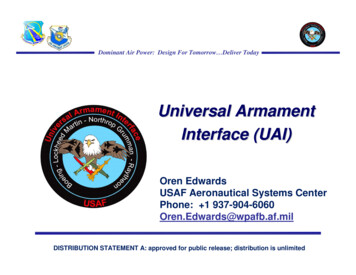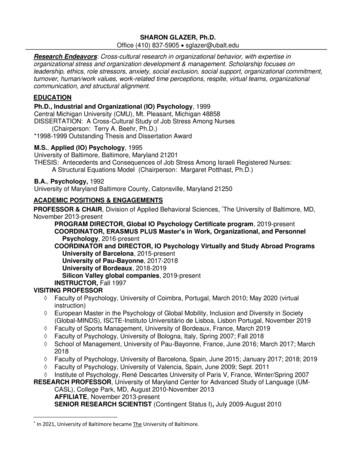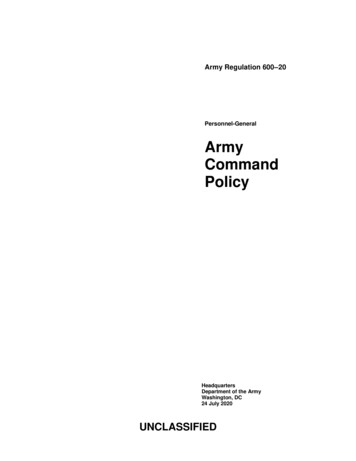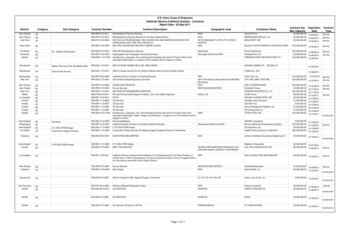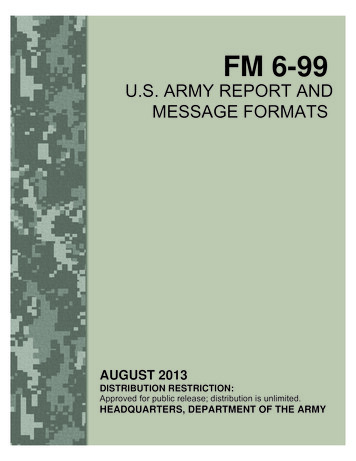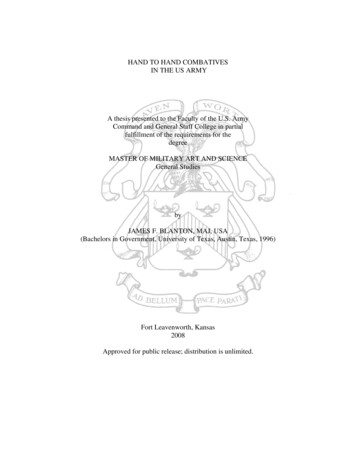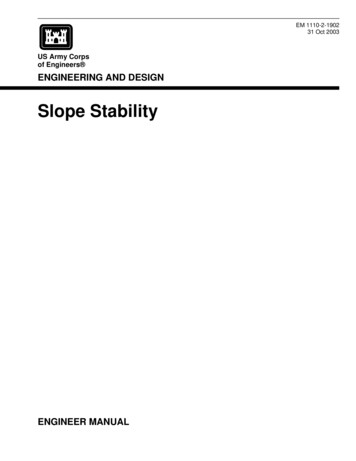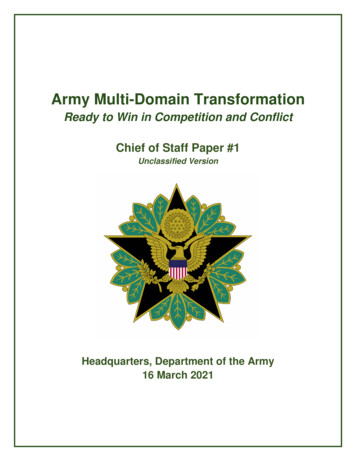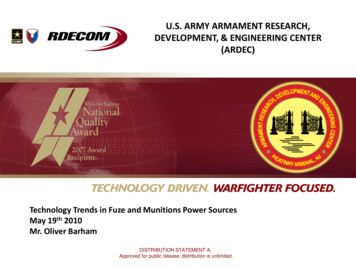
Transcription
UnclassifiedU.S. ARMY ARMAMENT RESEARCH,DEVELOPMENT, & ENGINEERING CENTER(ARDEC)Technology Trends in Fuze and Munitions Power SourcesMay 19th 2010Mr. Oliver BarhamDISTRIBUTION STATEMENT A.Approved for public release; distribution is unlimited.Unclassified
UnclassifiedOutline ARDEC Fuze Division Introduction OSD Joint Fuze Technology ProgramIntroduction ARDEC Fuze Capabilities and Technology Micro Electro-Mechanical Systems (MEMS) Proximity Fuzing Electronic Safing and Arming Devices (ESADs) Munition Power SourcesUnclassified
UnclassifiedFuze Division Mission Fuze RD&E Life Cycle– Fuzes– Safe & Arm Devices (Mechanical and Electronic) Related Technologies Advanced SensorsLow Cost, Small, Gun Rugged Electronic andMechanical Devices (MEMS)Electronic Fuze Setters– E3 Munition Assessments– Munitions Power Sources National and International Fuze Related Committees Army Fuze Safety Review Board DoD NDIA Fuze CommitteesUnclassified
UnclassifiedFuze Division Facilities Picatinny Arsenal, NJ– Building A (temporary) Office Space for 70 employees– Building B Electronics Laboratory– Building C Fuze Development Center– Building D Electromagnetic Environmental Effects Testand Evaluation Laboratory Co-located with ARL Adelphi Lab Center, MD– Office space for 45 employees– Lab facilities RF Proximity, electronic mechanical Prototype machine shopBRAC Consolidation at Picatinny with 17M state -of- the- art facilities constructionUnclassified
UnclassifiedJoint Fuze Technology Program (JFTP) JFTP is an OSD funded 6.2/6.3 national program established(FY10 start) to develop and mature technologies for improvingfuture fuzing performance, survivability, and reliability. JFTP governance and process is modeled after the JointMunitions Program (JMP) and the Joint Insensitive MunitionsTechnology Program (JIMTP). Program will leverage and be synergistic with projects in JMP,JIMTP and individual Service S&T ProgramsUnclassified
UnclassifiedJoint Fuze Technology Program (JFTP)OUSD(AT&L)/PSA/LW&MTechnical AdvisoryCommitteeJOINT FUZE TECH PANEL OVERSIGHT COMMITTEEPROGRAM MANAGERSCharles Kelly, Lawrence Fan, Phil Gorman, Tim TobikFUZE AREA TECHNOLOGY GROUPSFATGI – Hard Target/ Survivable FuzingFATGII – TailorableEffectsFATGIII – HighReliability FuzingFATGIV – EnablingFuze TechnologiesChairDr. Howard White (AF)ChairGene Henderson (Army)ChairJohn Hendershot (Navy)ChairChris Janow (Army)Co-ChairsJohn Kandell (Navy)Danny Hayles (DTRA)Bill Konick (Army)Co-ChairsDaniel Lanterman (Navy)Dr. Eric Welle (AF)Co-ChairsSteve Smith (AF)Tom Crowley (Army)Danny Hayles (DTRA)Co-ChairsMatt Bridge (AF)Bruce Hornberger (Navy)SME ParticipantsSME ParticipantsSME ParticipantsSME ParticipantsUnclassified
UnclassifiedFuze Area Technology GroupsFATG I – Hard Target/ Survivable Fuzing1.1 Improved M&SFATG II – TailorableEffects2.1 Initiation and multipoint technologies3.1 Fuzing Architecture1.2 Fuze Environment1.3 Next GenerationFuzing HardwareFATG III – HighReliability FuzingFATG IV – EnablingFuze Technologies4.1 Common / ModularFuze Architecture3.2 Fuzing Components2.2 ESAD Based Multipoint Initiators3.3 UXO reductionfeatures2.3 MEMS Based Multipoint Initiators4.2 ComponentsTechnologies4.3 Proximity Sensors4.4 Weapons Effects &Damage Assessment2.4 Smart Fuzing:Algorithms, fuzingtiming and control4.5 Fuzing PowerSourcesUnclassified
UnclassifiedARDEC Fuze Capabilities and TechnologyMicro Electro-Mechanical Systems(MEMS)Unclassified
UnclassifiedARDEC S&T Investment: MEMS2002-2008 S&T Development:– High-aspect ratio (HAR) metal MEMS fabrication*– MEMS omnidirectional g-switch*– MEMS S&A and Micro-Scale Firetrain (MSF)– Explosive inks and direct-write loading of MSF– Electromagnetic and piezoelectric setback generators*Unclassified
Unclassified40mm HEDP MEMS Program DescriptionImplement MEMS mechanical S&A device and direct-write explosive inkloading technology to improve the fuzing system & explosive train of the M433& M430 40mm HEDP cartridgesMEMS micro-electro-mechanical systemsM430HEDP high-explosive, dual-purpose New fuze architecture Electronic initiation vs. stab detonatorMEMS Command-arm-enableS&A Self-destruct capability (reduce UXO) More accurate arming distance Improved reliability on soft targets & graze SetbackGenerat MEMS G-switch arrayor Drop-in replacement for current fuzesProgram Objectives: Demonstrate 40mm MEMS fuze, May 2010 Fuze & cartridge integration and test, FY10-11 Cartridge Qualification and TDP, FY12-13Mk19Unclassified
UnclassifiedMEMS G-Switch (Impact Sensor) MEMS Inertial Sensor“Lucey” G-switch– Surface-mount to standard PCBMEMS G-Switch– All metal on ceramic substrate– Packaged at the wafer level with hermetic bonds Normally-open switch– 95% volume reduction from “Lucey” switch– Omni-directional sensitivity Independent directional contacts, x, y, zIndependent radial spin sensitivitySetback soft/hard impact, spin, grazeRobust in overshock– 50- to 10,000-Gs range thresholds– Tested to 45-kGs at BP, 75-kG at ATK Potential for transition to multiple programs Customer Interest:– ATK, 3800 ea. for XM25,30mm STAR ATO– ARDEC 900 ea., MK19 HEPD 40mm- M918UnclassifiedSpringMassCeramicSubstrate1-2 mm 3
Unclassified40mm MEMS DEMO – May 2010Unclassified
UnclassifiedMetal MEMS Device Application TrendsLarge- & Med-Cal S&A and Micro-scale Firetrain Integrations 105mm and 155mm, ARDEC Fuze & Power ATO 50mm, Enhanced Area Protection System 40mm, 40mm MEMS Fuze 30mm, STAR (scalable technology for adaptive response) ATO 25mmNon-spin S&A Applications Hand Grenade, replace M228 fuze 50mm, Enhanced Area Protection SystemInertial Mechanical Switches Omnidirectional g-switch High-current uni-axial g-switch Integrating g-switchNew Platforms AFRL Cyborg moth project Other lightweight/small platform integrationsUnclassified
UnclassifiedARDEC Fuze Capabilities and TechnologyProximity Fuzing TechnologyUnclassified
UnclassifiedJFTP Next Generation Proximity Effort Develop a next-generation low cost sensor technology with: Enhanced battlefield performance Improved Electronic Counter-Measure (ECM) resistance Better immunity to reverse engineering Use a tri-service Integrated Product Team (IPT) to select the besttechnology for a wide array of applications Adaptable for a wide array of systems and target types Software defined Height of Burst (HoB) Address concerns of the DoD Fuze IPT and Project ManagerCombat Ammunition Systems (PM CAS) regarding the existing stateof proximity sensor technology Maintain the US lead in proximity sensor technologyUnclassified
UnclassifiedJFTP Next Generation Proximity EffortTechnology Investment Schedule (FY)Tasks101112131415Requirements ProcessSimulations and Algorithms3Antenna / Transceiver/ FPGADevelopmentLaboratory Prototype34TRL5TRLDetailed DesignMiniaturized software definedproximity sensorEvaluation and Field test6 TRLFunding JFTP ( K)Current Year MilestonesObjectiveThis program addresses the Department of Defense (DoD) need to develop anext-generation proximity fuze technology to replace the current FrequencyModulated Continuous Wave - Directional Doppler Ratio Ranging (FMCW-DDR)proximity sensors. M1: Joint Proximity Sensor RequirementsM2: QFD Technology Down SelectM3: Refined Task AllocationsM4: Frequency AllocationTechnical ApproachLeveraging and Transition Opportunity Tri-Service IPT down select to highest payoff technology approach Advanced antennae, transceivers, and signal processing algorithms capable offrequency agility Low cost anti-tamper techniques for improved reverse engineering protection Software defined proximity sensors with selectable standoff and improvedelectronic countermeasure protection Technology leveraging from Fuze and Power Army Technology ObjectiveProgram Endorsed by Project Manager for Conventional Ammunition systems (PM CAS) Potential insertion into XM1156 Precision Guidance Kit (PGK), M782 MultiOption Fuze for Artillery (MOFA), M734A1 Multi-Option Fuze for Mortars (MOFM)Unclassified
UnclassifiedProx. Sensor for Tailorable WarheadsTechnology Investment Schedule (FY)Tasks101112131415Target CharacterizationM&S Toolset Development3TRLAlgorithm DevelopmentLaboratory Prototype4 5 TRLAlgorithm RefinementFunctional Prototype6 TRLFunding JFTP ( K)Leveraged ( K)Current Year MilestonesObjective Develop a sensor system to crudely identify primary features of differenttarget scenes in the end-game encounter Provide information to make smart decisions on “how” and “when” toinitiate tailorable warheads M1: Target Set Selection – Mar10 M2: Fuze Sensor Data Acquisition System –Jun10 M3: Baseline Simulation toolset – Oct10Technical ApproachLeveraging and Transition Opportunity Development and validation of M&S toolset to aid in the design of signalprocessing techniques capable of producing end-game targetclassification data and accurate standoff measurements Design of miniaturized low noise analog, digital, and RF sensor circuitry Implementation of advanced DSP algorithms in commercial FPGA/DSPdevices 105mm Precision Munition (PEO Ammunition)Very Affordable Precision Projectile (VAPP)Scalable Technology for Adaptive Response ATOSensor, Warhead and fuze Technology Integrated for Combined EffectsATO Mortar & Artillery Proximity Fuzes (PM Conventional Ammunition Systems)Unclassified
UnclassifiedAirburst Non-Lethal Munition (ANLM)Point DetonatingBackup FeatureDual Mode SettingCollar and SelectorPiston ActuatorFiringMechanismSetback and SpinInitiated ReserveBatteryStandard Production M550S&A (No modification)Firing Pin to InitiateM55 Stab Detonator Airburst Non-Lethal Munition (ANLM) is a non-lethal low velocity 40mm grenade fullycompatible with existing M203/M320 weapon platforms. User settable fuze – two modes: 5m proximity and 5m proximity with delay (roomclearing). Ability to employ non-lethal effects lasting up to 30 seconds, in a complementary nonlethal manner to enhance combined- arms battlefield effectiveness by minimizingmass physical destruction of people, materiel, infrastructure, and the environment. Allow tactical commander the option to tailor a response to situations when a lethalresponse in not the best option.Unclassified
Unclassified30mm Apache Gun System Prox. FuzeProblem:M789 HEDP round utilizes an impact mechanism thatdoes not function fast enough when fired at personneltargets in soft or sandy soils. Most of the warheadfragments are absorbed by the ground.Objective:Develop a proximity sensor capability confined with theM759 fuze envelope utilizing the existing S&A.POC: David Errera/Steve Stephey, ARDEC FuzeDivisionUser/Customer: PM-MASBenefits to the Warfighter:Improve effectiveness of 30mm Apache gun systemagainst personnel targets.Tasks (FY10/11) Evaluate prox sensor using TM projectile. Continue tactical fuze design & integration Award ATK support contract Identify/develop custom components Fab, assemble, test sub-assy & demo hardware Conduct 30mm demo testSchedule (FY10/11)Prox FuzeConceptM789 HEDP 30mmround with M759 FuzeUnclassified
UnclassifiedORIOLE Medium Altitude Prox. SensorNominal Standoff: 150mAccuracy: /- 20%Target Type: HoB on Dense Tree Canopy-Software defined proximity sensor usingcommercially available devices-Sensor output used to deploy parachute for softdelivery of the ORIOLE systemLocation ofProximity SensorCustomer: Army Research LaboratoryDesigned, Fabricated, and Characterized in house at ARDECUnclassified
UnclassifiedProx. Sensors for UAVsARDEC is designing and building proximity hardware fora variety of UAVs and UAV munitionsUnclassified
UnclassifiedARDEC Fuze Capabilities and TechnologyElectronic Safing and ArmingDevices(ESADs)Unclassified
UnclassifiedElectronic Safing and Arming Devices All Electrical No moving parts No primary explosives High current / voltage devices High reliability High cost Example applications: Rockets, Missiles, Recoverable UAVsUnclassified
UnclassifiedProposed ESAD Cost/Size Reduction JFTP Proposed ProgramModel and analyze transformer loading during setbackevents. Develop test fixturing to provide alternatemounting configurations for transformers. Developunderfill and assembly methods for mountingtransformers to allow survival of artillery setback andprevent the failure of its brittle materials.Incorporate SiC switches from multiple manufacturersinto ESAD firesets. Work with manufacturers to reducepackaged size for ESADs.Low Energy Exploding Foil Initiators (LEEFI) bridgesubstrates to be developed leveraging previous initiatorwork. Strict process control to minimize variation ofbridge structures is necessary to maintain consistentinitiation timesUnclassifiedTransformerARL SiC Device
UnclassifiedESAD: Non-Proximity Application ARDEC is designing and building ESADs for UAV applications, and othersthat do not employ proximity sensorsUnclassified
UnclassifiedESAD: STAR ATO 105mm Fuze DevelopmentProximity SensorMETC/ARDEC In-House EffortHeight of burst sensorESAD(s) System DesignSchematic Capture / Physical LayoutAlgorithm ArchitecturesFirmware ImplementationsESADs Safety System DevelopmentESAD Laboratory PrototypesFirmware DevelopmentFireset Design/DevelopmentEnvironmental Sensors (Setback Switch / SpinSwitches)Contracted/OGA EffortsElectronic Development Corporation (EDC)Description:-One of three thrust efforts under STAR ATO-Increased lethality for Precision 105 mm (VAPP) while minimizingcollateral damage-Efficient thermal battery for Fuze and GNC-Innovative warhead initiation schemes-Hardened fuze for penetration-Optimized HOB sensor for precision engagement- ESAD prototyping- Electronics integrationU of Florida – Electronics Communications Lab (ECL)- HOB Sensor Algorithm Support- HOB Modeling & SimulationCustomer: PM CASL3-Fuze Ordnance Systems (L3-FOS)Requirements: TRADOC PAM 525-66: FOC 05-01, 05-02, 09-01; CNAARL - Adelphi, MD- Setback Sensor Dev
Mr. Oliver Barham. DISTRIBUTION STATEMENT A. Approved for public release; distribution is unlimited. Unclassified Unclassified ARDEC Fuze Division Introduction OSD Joint Fuze Technology Program Introduction ARDEC Fuze Capabilities and Technology Micro Electro-Mechanical Systems (MEMS) Proximity Fuzing Electronic Safing and Arming Devices (ESADs) Munition Power Sources .
